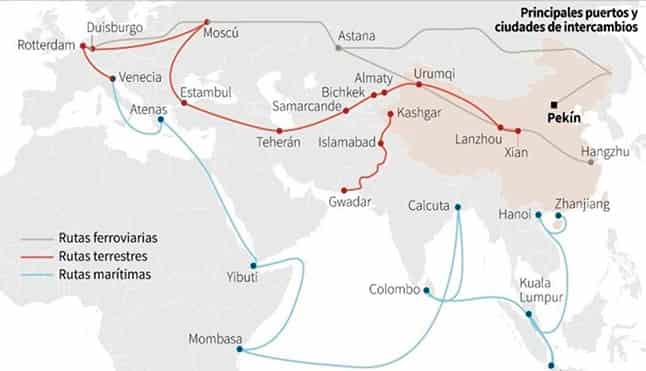
This project is a personal initiative of Chinese President Xi Jinping and aims to develop infrastructure for commercial exchange between Asia, Europe and Africa
China hosts the second summit of the New Silk Roads, which attracts more and more nations to this global infrastructure program, despite the criticism it raises about economic colonization. The initiative aims to improve trade relations between Asia, Europe, Africa and even beyond. It foresees the construction of ports, railroads, airports or industrial parks.
The project, a personal initiative of Chinese President Xi Jinping, divides Europeans and generates opposition in the United States, due to the risks of indebtedness and alignment of countries that benefit from Chinese loans.
The european countries
However, more than 37 heads of state and government will come to Beijing to attend this summit held Thursday through Saturday. Twenty-nine were present at the inaugural forum of 2017. And, above all, China has just been done last month with the important participation of Italy, the first G7 nation to join the project.
The head of the Italian government Giuseppe Conte will be at the summit. Switzerland is ready to join the Chinese initiative and its president Ueli Maurer will also go to Beijing. Russian President Vladimir Putin and other European, African and Asian leaders will do the same. But most Western European countries only send ministers and the United States will not have any high-level delegation.
The accession of Italy - a member of NATO and the European Union - caused heartache in both Washington and Brussels, and even within the very coalition in power in Rome, in which Interior Minister Matteo Salvini warned against the risk of colonization. For Italy, the protocol of agreement signed with China supposes that "it accepts the diplomatic initiative of Xi Jinping, and considers it good for the country, for China and for the rest of the world", observes the analyst Thomas Eder, of the Mercator Institute (Germany).
The investments
Since the launch of the New Silk Routes in 2013, China has invested a total of 80,000 million euros in several projects, and banks have lent between 175,000 and 265,000 million euros, according to Xiao Weiming, the Chinese head in charge of the program.
It is a flow of liquidity that raises fears about the indebtedness of the beneficiary countries. For example, Sri Lanka, unable to cope with its credits, had to hand over to Beijing control of a deep-water port for a period of 99 years. And Montenegro has been severely indebted after taking a loan of 800 million euros from a Chinese bank to build a highway.
China claims that these loans are the only means for poor countries to finance their development. Xiao Weiming rejects the notion of "debt trap" wielded by critics. According to some experts, adherence to the Silk Roads is a way to assume the rules, technology and influence of Beijing.
For China, the initiative also allows it to release its surpluses in foreign markets. In effect, it guarantees channels for its "surplus industrial capabilities, a product of the Chinese economic model," observes James Bowen of the Australian think tank Perth USAsia Center.
"Chinese workers need work and China has materials to be exported and assembled in other countries," he says. The Chinese money comes in the form of loans and not donations, generating rejection of some countries, especially in Sri Lanka, Maldives and Malaysia, where opposition parties came to power last year denouncing the corruption of leaders and the opacity of his dealings with Beijing.
El Periódico Digital
